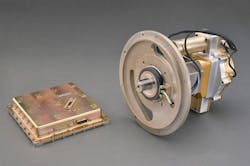Moog to provide electromechanical actuators for launch motion control in DARPA Gremlins unmanned aircraft
EAST AURORA, N.Y. – U.S. military researchers needed electromechanical actuators for launching and retrieving an experimental unmanned aerial vehicle (UAV) that seeks to overwhelm enemy air defenses. They found their solution from Moog Inc. in East Aurora, N.Y.
Moog officials announced that the company’s hardware played a critical role in a U.S. Defense Advanced Research Projects Agency (DARPA) X-61A Gremlins Air Vehicle during the program's fourth flight test event in October at Dugway Proving Ground, Utah.
The Gremlins demonstration system flew three Gremlins to conduct four individual flight sorties for a combined 6.7 hours of flight, including the 1.4-hour airborne recovery mission.
The overarching goal of the Gremlins Program, managed by DARPA's Tactical Technology Office, is to demonstrate aerial launch and recovery of multiple low-cost, reusable, unmanned aircraft.
Related: High-reliability motor controller for unmanned vehicle and military uses introduced by DDC
The DARPA Gremlins program seeks develop the ability to use C-130 military aircraft to launch drone swarms of networked and cooperating unmanned aircraft for electronic attack and reconnaissance missions from standoff ranges, and then use other C-130 utility aircraft to recover as many of these drones as possible.
The program relies on relatively inexpensive UAVs in volley quantities to saturate enemy defenses. The Gremlins approach would launch swarms of UAVs with a variety of surveillance and electronic warfare (EW) payloads from aircraft beyond enemy air defenses, and then recover surviving UAVs when they have completed their missions.
The idea is to design UAVs that are inexpensive enough so that occasional losses would not compromise the overall mission. Furthermore, the drones would communicate and cooperate with one another, so surviving drones could assume the roles of those unmanned aircraft lost during the mission. Moog is working with Dynetics Inc. in Huntsville, Ala., on the Gremlins project.
Moog’s electromechanical actuation systems provide precision motion control for several elements of the Gremlins demonstration system including Gremlin tail fin control, Gremlin wing deploy, and fin control for the attitude-controlled "Bullet" which is a key element in the recovery system.
These actuation systems work in a collaborative environment with Dynetics to achieve the rapid integration and flight test schedule that is expected for DARPA programs.
The solutions leverage previously flight-qualified elements and commercial off-the-shelf (COTS) components striking a balance between reliability and cost. The electromechanical actuation system enables flying several different sorties, enabling Dynetics to meet the critical goal of 24-hour refurbishment for return to flight.
For more information contact Moog online at www.moog.com, Dynetics at www.dynetics.com, or DARPA at www.darpa.mil.
About the Author
John Keller
Editor-in-Chief
John Keller is the Editor-in-Chief, Military & Aerospace Electronics Magazine--provides extensive coverage and analysis of enabling electronics and optoelectronic technologies in military, space and commercial aviation applications. John has been a member of the Military & Aerospace Electronics staff since 1989 and chief editor since 1995.

